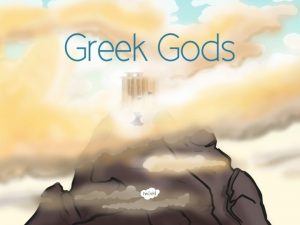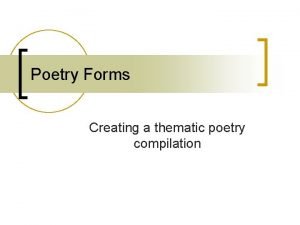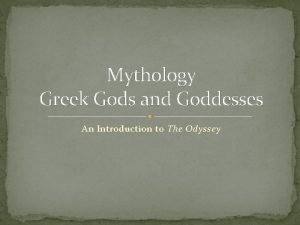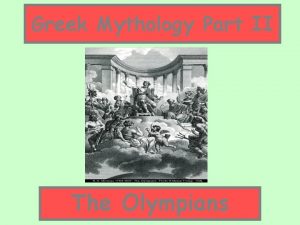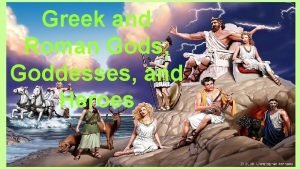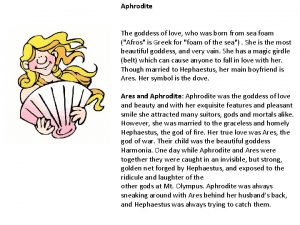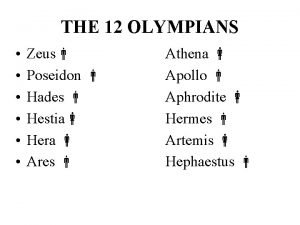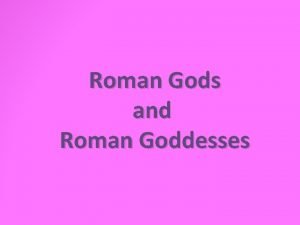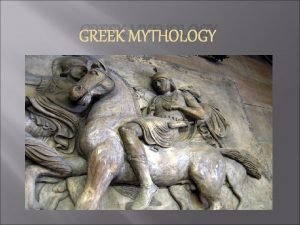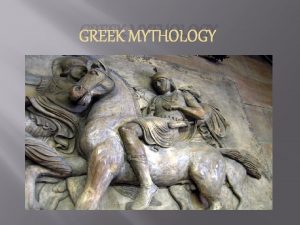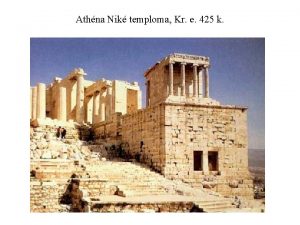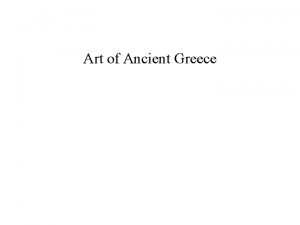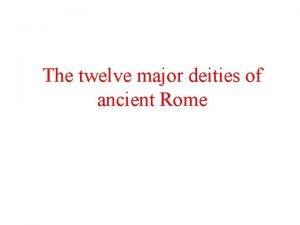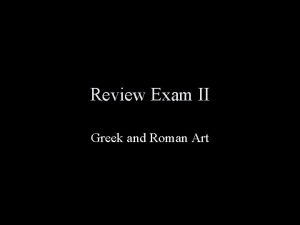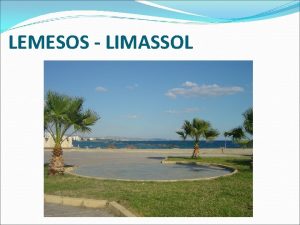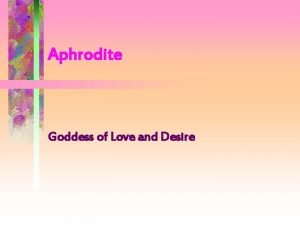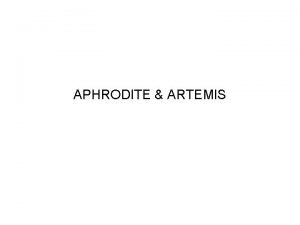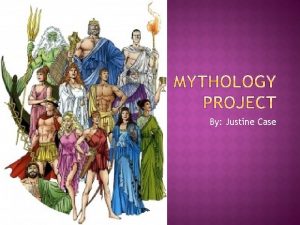Erasmus course Kyprida Aphrodite Limassol Part 5 CONTENTS























- Slides: 23

Erasmus+ course Kyprida Aphrodite Limassol Part 5

CONTENTS • • • Aphrodite in Greek Mythology Perceptions for birth Depictions and symbols Worship of Aphrodite on Cyprus Palepaphos Amathus

Aphrodite in Greek Mythology Aphrodite was the Olympian goddess with many expressions: • She was the goddess of love, desire, pleasure, fertility and beauty. • She was protector of sailors and goddess of the sea. • She was also protector of prostitutes. • She was honoured as the goddess of war. Apart from her natural beauty, she also had a magical girdle that compelled everyone to desire her.

Perceptions for birth There are two myths for her birth. 1 st Myth According to one myth, Hesiod mentions in his Theogony that Aphrodite was born from the white foam (aphros) produced by the severed genitals of Uranus (Heaven), after his son Cronus threw them into the sea.

There are two versions of the myth: A. Then she was blown to the island of Cythera by the Wind Zephyrs and as she arrived on the shore on a shell, she found the Seasons there waiting for her. They were dancing and singing her praises. They were very beautiful, but they were nothing compared to Aphrodite. They clothed her in golden robes and jewels and led her to Mount Olympus. Botticelli's Birth of Venus (on display in the Uffizi Gallery in Florence).

Cythera (Greece)

B. Aphrodite is usually said to have been born to Petra tou Romiou, near her main place of worship, Paphos, on the island of Cyprus. is That’s why she is sometimes called "Cyprian", especially in the poetic works of Sappho. These stories may preserve traces of the migration of Aphrodite's cult from the Middle East to mainland Greece. Petra tou Romiou is an interesting geological formation of huge rocks along one of the most beautiful coastlines on the island, located on the southwest coast of the Pafos (Paphos) district. ‘Petra tou Romiou’ (The Rock of the Greek)


2 nd Myth Aphrodite was considered a daughter of Zeus and Dione, the mother goddess whose oracle was at Dodona. Aphrodite herself was sometimes also referred to as "Dione" seems to be a feminine form of "Dios", "of Zeus", the genitive form case of Zeus, and could be taken to mean simply "(she) that belongs to Zeus" in a generic sense. Aphrodite might, then, be an equivalent of Rhea, the Earth Mother, whom Homer relocated to Olympus. Zeus and Dione

In Greek mythology, Aphrodite lived on Mount Olympus with the other gods and goddess. The other gods feared that Aphrodite's beauty might lead to conflict and war, through rivalry for her favours; so Zeus married Aphrodite with Hephaestus the homely craftsman-god. Despite this, Aphrodite followed her own inclinations, and had many lovers — both gods, such as Ares, and men, such as Anchises. She played a role in the Eros and was both lover and surrogate mother of Adonis. Many lesser beings were said to be children of Aphrodite and Hephaestus

Depictions and symbols She was depicted as a beautiful woman often accompanied by the winged godling Eros (Love). Her attributes included a dolphin, rose, myrtie, sparrow, girdle, swan, dove, apple, Taurus, scallop shell and mirror.

Personal Information Husbands Hephaestus, Ares, Poseidon, Hermes, Dionysus, Adoni s, and Anchises Children Eros, [1] Phobos, Deimos, Harmonia, Pothos, Anteros, Himeros, Hermaphroditus, Rhodos, Eryx, Peitho, Euno mia, The Graces, Priapus, Aeneas Adonis Parents Uranus[2] or Zeus and Dione[3] Brothers-Sisters Aeacus, Angelos, Apollo, Ares, Artemis, Athena, Diony sus, Eileithyia, Enyo, Eris, Ersa, Hebe, Helen of Troy, Hephaestus, Heracles, Hermes, Minos, Pandia, P ersephone, Perseus, Rhadamanthus, the Graces, the Horae, the Litae, the Muses, the Moirai, or the Titans, the Cyclopes, the Meliae, the Erinyes (Furies), the Giants, the Hekatonkheires Roman equivalent Venus

In classical sculpture and fresco she was usually depicted nude or semi -nude.

Worship of Aphrodite on Cyprus Palepaphos The worship has its origins to Achaean colonists, who adopted the worship of a native fertility goddess named Astort (the Canaanite form of Ishtar), who they Hellenized as Aphrodite. Names: Astort Aphrodite Paphian Wanassa The worship of Aphrodite was officially established on Cyprus in 1500 BC, with the building of a hilltop temple on Palepaphos (Palea Paphos). The Temple of Aphrodite stood on a hill about 2 km from the, sea. The town of Palea Paphos soon created around the temple. Homer referred to the goddess as the "Cyprian" as early as the 8 th century BC, and she was called the "Paphian" in the 6 th century BC. Inscriptions at Palea Paphos call her simply Wanassa, "the lady. “ The 4 th century AD worship of Aphrodite has stopped Palepaphos

Palepaphos Museum at Palepaphos Coin from Palepaphos

Amathus The ancient town of Amathous is situated on the south coast of Cyprus, about 7 km east of the town of Lemesos founded by Greek Mycenaean settlers in the 12 th to the 11 th centuries BC Amathous was one of the biggest ancient cities of the island where Kyprida Aphrodite was worshiped. The town acquired special wealth as one of the Kingdoms of Cyprus, and had remarkable commercial relations both with the Aegean and the Syropalestinian coast. According to the legend, was settled by one of the sons of Heracles, who was worshipped there.

Acropolis

Acropolis 11 th century B. C. A tomb at the north edge of the hill, known as the tomb of Ariadne According to other legends, Ariadne, the beautiful daughter of Minos, who fled from Labyrinth in Crete with Theseus, was later abandoned in Amathus. She died there while giving birth to her child and was buried in a tomb. Two big monolithic vessels were used which dominated the site on the east edge of the hill. One of them is partially preserved today in situ while the other one was transported in the 19 th century to Paris where it is exhibited today in the Louvre. During this period, Cypriot Aphrodite took the characteristics of the Egyptian goddess and vessels Had numerous representations.

Temple of Aphrodite The ruins of the Roman Temple of Aphrodite occupy a large part of the acropolis. It was built over the ruins of a Hellenistic temple for which we do not have much information. The Roman temple was one of the greatest centers of worship in Cyprus during antiquity and one of the most important places of worship. It was built at the end of the 1 st century A. D. It seems that in the 5 th century A. D. the area surrounding the south part of the temple was used as a place of worship by the first Christians. In the 7 th century the temple was already destroyed and in its place a large three-aisled basilica was built.

Agora and the baths The agora is located in the lower town. The area south of the agora comprised of a closed circular area and annexes. The bath along with part of the west portico of the agora date to the Hellenistic period and constitute the earliest indications of human activity in the area. Sewage system


The Port The external port of the city was situated in front of the agora and its ruins are preserved today under the sea. The port was built at the end of the 4 th century B. C. by Demetrios Poliorcetes, as part of the defense of the town during the period of the quarrel with the Ptolemys for the domination of Cyprus. The port's lifespan was short since it was covered by sand. In front of the agora an internal basin of the port existed where the sailors had the opportunity to pull the ships out of the water in order to better protect them from the wind.

Aphrodite and Adonis The myth of Aphrodite and Adonis is related with Amathounta area. Ares, the God of War and Aphrodite’s lover, hears that Aphrodite loves the youth Adonis, got really jealous. Adonis was interested in hunting. Aphrodite begged Adonis to give up the dangerous sport he enjoyed because she could not bear to lose him, knowing that the young man would have a terrible end. Adonis ignored her advice and was killed while hunting by a wild boar, that was actually God Ares. When Adonis died, Aphrodite with Adonis still in her arms, Aphrodite turned the blood drops that fell from his wounds onto the soil into windflowers (the short-lived anemone) as a memorial to their love. Anemones sprung from the blood of Adonis and his spirit returned to the underworld. In response to the tearful goddess, Zeus determined that Adonis should stay just for the half of the year in the Underworld.
 Ims private school
Ims private school Minerva limassol
Minerva limassol Importance of edp
Importance of edp Facts about zeus the greek god
Facts about zeus the greek god Zeus strength and weakness
Zeus strength and weakness Thematic poetry
Thematic poetry When was aphrodite born
When was aphrodite born Aphrodite powers
Aphrodite powers Helios roman name
Helios roman name Aphrodite weapon symbol
Aphrodite weapon symbol Hermes siblings
Hermes siblings Zeus children
Zeus children Artemis domain
Artemis domain A traditional story that explains a belief system
A traditional story that explains a belief system Hephaestus realm
Hephaestus realm Realm of zeus
Realm of zeus Ares realm and symbol
Ares realm and symbol Knidoszi aphrodité
Knidoszi aphrodité Aphrodite of knidos period
Aphrodite of knidos period Aphrodītē
Aphrodītē Aphrodite diagram
Aphrodite diagram Aphrodite smagadi
Aphrodite smagadi Aphrodite of knidos
Aphrodite of knidos Aphrodite smagadi
Aphrodite smagadi



